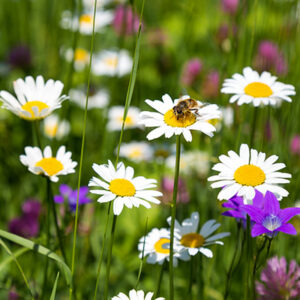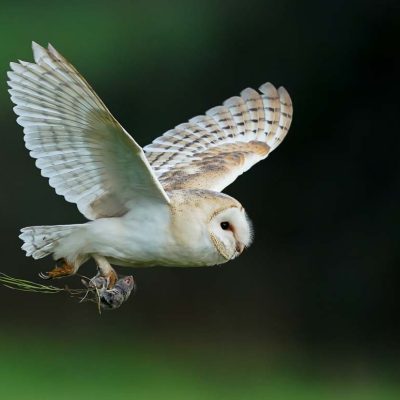Wildflower Wonderland: The Beautiful Meadows of Lincolnshire’s Wolds
You’re in for a treat if you head to the rolling hills of the Lincolnshire Wolds.
This picturesque area of outstanding natural beauty is home to some of England’s most stunning wildflower meadows. As soon as you arrive, you’ll be greeted by fields of poppies, cornflowers, and oxeye daisies swaying in the breeze. The vibrant colours and sweet scents are an assault on the senses.
These meadows aren’t just a pretty sight, though. They provide a haven for rare birds, bees, and butterflies. Spotted flycatchers swoop and dive through the air, hunting for insects, while small copper and common blue butterflies flutter between flowers. If lucky, you might glimpse an increasingly rare grayling or small pearl-bordered fritillary butterfly. With over 400 species of plants and wildflowers and more than 200 bird species to be found, there are natural wonders around every corner in this wildflower wonderland. Discover your slice of countryside paradise in the Lincolnshire Wolds.
Discovering the Lincolnshire Wolds AONB
The Lincolnshire Wolds Area of Outstanding Natural Beauty is one of England’s best-kept secrets. This picturesque countryside in the East Midlands is home to rolling chalk hills, ancient woodlands, and wildflower meadows as far as the eye can see.
As you explore the Wolds, you’ll discover a natural wonderland. The meadows are carpeted with wildflowers like oxeye daisies, poppies, cornflowers, and knapweed in late spring and summer. These grasslands are a haven for bees, butterflies, and birds. You might spot rare species like the shrill carder bee or the grayling butterfly fluttering between flowers.
The Wolds are also an essential habitat for endangered birds such as the skylark, lapwing, and yellow wagtail. If you’re lucky, you may glimpse a barn owl silently hunting for voles in the twilight. Listen for the hooting of little owls and the churring of nightjars at night.
With over 3,000 miles of public footpaths and bridleways, the Lincolnshire Wolds are perfect for walking, cycling, and horse riding. As you wander the trails, you’ll come across picturesque villages, ancient churches, and historic windmills. Stop for a pint of ale or a ploughman’s lunch at one of the charming country pubs.
Whether you want to enjoy a picnic amid the wildflowers, spot rare birds soaring over the hills, or find solitude in nature, the Wolds offer abundant open spaces and fresh air. This secret countryside gem is waiting to be explored. Lose yourself in the peaceful meadows and winding lanes of Lincolnshire’s Wolds.
Wildflower Meadows: A Sea of Colour in Summer
Come summer, the meadows of the Lincolnshire Wolds burst into colour as wildflowers bloom. These grasslands are home to over 30 species of wildflowers, many rare or endangered.
- Oxeye daisies with yellow centres and white petals sway in the breeze as far as the eye can see.
- The pink-purple blooms of common knapweed attract butterflies and bees.
- Yellow rattle, blue harebells, and red poppies add splashes of colour.

- Rare orchids like the bee orchid hide among the grasses, their complex flowers attracting pollinators.
To experience these floral wonderlands, head to sites like Fulletby Meadows or Tealby Meadows. The flowers typically peak in June and July. As you wander the trails, watch for birds like skylarks, grey partridges, and barn owls hunting for voles in the grass. You may spot a hare or roe deer in the distance if you’re lucky.
These meadows have been managed for decades to preserve their biodiversity. Farmers delay mowing and limit fertilizer use, allowing wildflowers and grasses to flourish. Their efforts have created habitats for many endangered species, like the shrill carder bee and grayling butterfly.
When peak wildflower season has passed, the meadows are mowed and baled for hay. The cuttings are then removed, preventing nutrients from building up in the soil. This yearly cycle has sustained these meadows for generations and, with continued conservation, will keep them blooming for generations to come. A sea of colour and life, the wildflower meadows of the Wolds are a wonder to behold.
One of Britain's Richest Areas for Wildlife
The Lincolnshire Wolds is one of Britain’s richest areas for wildlife, with many endangered species calling it home.
Flourishing Flora
The rolling chalk hills and secluded valleys are carpeted in wildflower meadows, especially in summer. Over 20 species of orchid can be spotted, including the rare fragrant orchid. The slopes are awash with cowslips, oxeye daisies, meadowsweet, and knapweed. These flower-filled grasslands provide vital habitats for pollinators like bumblebees, butterflies, and hoverflies.
Birdwatcher’s Paradise
Rare birds are attracted to the Wolds, including corn buntings, grey partridges, and turtle doves. The scrubby hedgerows offer shelter and nesting spots for linnets, yellowhammers, and whitethroats. Red kites and buzzards soar over the treetops while skylarks sing high above the meadows. The chalk streams and ponds are home to kingfishers, sand martins, and little ringed plovers.
More Than Meets the Eye
Though the landscape may seem barren at first glance, a closer look reveals a wealth of wildlife. Badgers, foxes, and roe deer emerge at dusk while brown hares bound through the long grass—the rare great crested newt breeds in the ancient dew ponds and ditches. Glow worms light up the woodland edges on warm summer nights.
Conservation Efforts
Over 97% of Britain’s wildflower meadows have been lost since World War II. The Lincolnshire Wolds is a stronghold for these endangered habitats. Conservation groups work to restore lost meadows, plant native trees, and protect vulnerable species. By preserving this picturesque pocket of the countryside, they safeguard a vital lifeline for wildlife in an increasingly developed world.
The Wolds offer a glimpse into Britain’s natural heritage. Their sweeping beauty and ecological importance make them a place worth protecting for future generations. If you’re looking to connect with nature, there are few finer destinations than the wildflower wonderland of Lincolnshire’s Wolds.
Lincolnshire Wildflower Seeds
At Wildahome, we’re working with many farmers and landowners in the Wolds to create habitats to attract insects and birds.
Our wildflower seeds are being used on both farm-scale and garden projects,
throughout the region, and our sourcing partnership team arranges the collection of wildflower seeds specific to the geology and climate of the area.
We can supply meadow mixes alongside single-species wildflower seeds, and all of our seeds are sourced to suit the soil and climate conditions of the Lincolnshire Wolds.
Lincolnshire Wildflower seed mats are also available in both 100% wildflower seed or 80/20 grass mix and are particularly suitable to banks and sloping ground and areas where minimal maintenance is required.
Rare but Thriving: Spotting Endangered Species
The Lincolnshire Wolds AONB is home to several endangered species that continue to thrive in this picturesque landscape. Keep an eye out for these rare but resilient residents on your visit.
Skylarks
The skylark is a small brown bird known for its melodious song and aerial displays. Skylarks build their nests on the ground in open grasslands, feeding on seeds and insects. Their numbers have declined by over 50% in the last 40 years due to habitat loss, so the Wolds provide an essential stronghold for this endangered songbird. Listen for their distinctive trilling song and look for them hovering high above the meadows.

Barn Owls
With their ghostly white heart-shaped faces and mottled brown plumage, barn owls are a sight to behold. These nocturnal raptors nest in old barns, outbuildings and tree hollows throughout the Wolds.
Though still endangered, barn owl numbers have increased recently thanks to nest box schemes and better habitat management. You may spot one quartering over open fields at dawn and dusk, searching for small mammals like voles and mice.
Yellow Wagtails
The yellow wagtail is a colourful bird that breeds in wet meadows and pastures. The male has a yellow head, underparts, olive-green back, and a distinctive long tail that frequently wags up and down. Wagtails walk through long grass snatching up insects and spiders. They have declined across much of England due to habitat loss, so the Lincolnshire Wolds provide a vital breeding ground for this striking little bird. Look for them in damp grasslands and along the edges of ponds.
Protecting and maintaining the mosaic of habitats in the Wolds, from wildflower meadows to hedgerows and wetlands, these endangered species have a fighting chance to endure and enrich this picturesque landscape for generations. Keeping the land alive and thriving with biodiversity will ensure the survival of these rare but resilient residents.
The Lincolnshire Wolds - A Nature Haven Off the Beaten Path
So there you have it, a wildflower wonderland waiting to be explored on your doorstep. The Lincolnshire Wolds may be off the beaten path, but that adds to their charm. Rolling hills, sweeping views, and colourful carpets of flowers as far as the eye can see, what more could you want in a summer adventure?
Pack a picnic, lace up your hiking boots, and head out to discover one of England’s best-kept natural secrets. The wildflower meadows are calling your name. All that’s left to do is answer.
Frequently Asked Questions – Wildflowers and Seeds in Lincolnshire
What are the best wildflowers to sow in Lincolnshire?
Some popular wildflowers to sow in Lincolnshire include cornflowers, poppies, oxeye daisies, meadow cranesbill, and red campion. These species are well-adapted to the region’s climate and soil conditions.
When is the best time to sow wildflower seeds in Lincolnshire?
The ideal time to sow wildflower seeds in Lincolnshire is spring or autumn. Spring sowing (March to May) allows the seeds to establish before the summer heat, while autumn sowing (September to October) takes advantage of the cooler temperatures and moist soil conditions.
How do I prepare the soil for sowing wildflower seeds in Lincolnshire?
First, remove any existing vegetation, weeds, or grass to prepare the soil. Loosen the top layer of soil using a rake or cultivator to create a fine tilth. Wildflowers generally prefer poorer, less nutrient-rich soils; however, adding organic matter, such as compost, may be used sparingly to improve soil fertility and drainage. Avoid using fertilizers high in nitrogen, as this can promote excessive leaf growth at the expense of flowers.
Are there any specific considerations for sowing wildflower seeds in urban areas of Lincolnshire?
When sowing wildflower seeds in urban areas of Lincolnshire, consider the available space and light conditions. Choose wildflower species suitable for smaller areas and partial shade, if necessary. Ensuring the site is free from pollution, and chemicals is also essential, as wildflowers are generally more sensitive than common garden plants.
What maintenance is required after sowing wildflower seeds in Lincolnshire?
After sowing wildflower seeds, keeping the area well-watered, especially during dry periods, is essential to aid germination. Once the wildflowers have established, avoid excessive watering, as they are typically adapted to withstand drier conditions. Regular weeding is necessary to remove any competing plants or weeds that may hinder the growth of the wildflowers. Cutting back the wildflowers after they have finished flowering is recommended to encourage new growth and prevent self-seeding. However, this step is optional if you want to promote natural reseeding.


